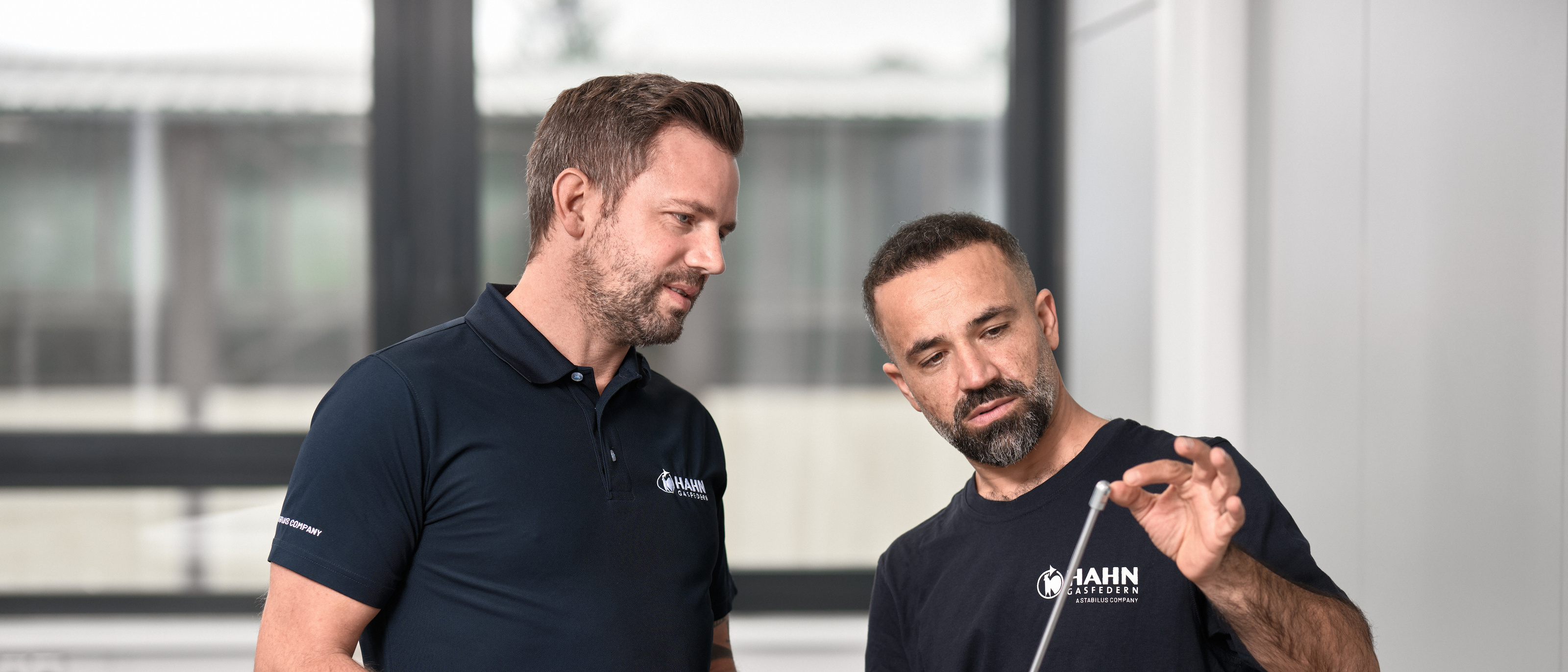Do you have specific questions about HAHN Gasfedern? Then take advantage of the fact that our customer service regularly FAQs – you can read the answers to them below. Here you will find almost everything you need to know about our high-quality gas springs in a simple, quick, and practical format. From how they work and how to install them correctly to information about delivery, complaints, and maintenance. We hope we were able to answer your question. However, if you couldn’t find an answer, you can still contact our customer service at any time – we will be happy to help you promptly!
Questions about delivery, returns and complaints
How long is the delivery time for HAHN gas springs?
Can a functioning gas spring be returned?
What if I have a complaint?
Why does the serial number/customer order number change?
Are HAHN gas springs subject to CE marking?
Does Hahn Gasfedern deliver orders to private customers?
Questions about installation and maintenance
How do you correctly install gas tension springs, gas pressure springs, and dampers?
Gas tension springs, gas pressure springs, and dampers must always be installed with the piston rod pointing downwards. If gas springs are installed incorrectly, then the seal is not in the oil, which increases the risk of a slip-stick effect and thus increases the chance of the gas spring failing more quickly. In addition, a gas pressure spring that is installed in the wrong direction has no end position damping. One way to get around this is to use a gas spring with a grease chamber. Here, it can be installed in either direction, but in this situation as well there is no end position damping of the gas pressure spring. You can find details about this in our technical specifications.
Does a gas spring need to be serviced?
Does a gas spring need to be protected from dirt?
It is not mandatory, but in extremely dirty conditions it is advisable to install the gas spring with a scraper or protective tube. These allow you to extend the service life of the gas spring. A scraper prevents dirt from getting into the gas spring. In particularly harsh conditions, such as with street sweepers, you can protect the piston rod from external influences and thus from possible damage using a protective tube.
How do you store gas springs correctly?
Gas springs should not be stored as stock items. If you nevertheless need to store your gas springs, the procedure is the same as for installation. Compression gas springs must be stored with the piston rod pointing downwards, and tension gas springs with the piston rod pointing upwards. For more information, see our technical specifications.
Can bearing damage occur?
If stored as directed, no pressure losses should occur, but the products should not be stored for longer than one year. When the gas springs are operated for the first time after a long period of rest, a sticking effect, the so-called slip-stick effect, can occur. In this case, higher forces are required to extend or retract the piston rod. If stored improperly, the seal may stick to the piston rod, causing the seal to be damaged when the gas spring is actuated.
Can a slip-stick effect occur with gas springs?
Can gas pressure springs, gas tension springs, and dampers be used as end stops?
Is there a length tolerance?
Can a gas spring be repaired?
Questions about the product and how it works
How does a gas spring work?
What are gas springs filled with?
How much does a gas spring weigh?
What is meant by progression in gas springs?
Does the force of a gas spring differ when extended and retracted?
Yes. Contact between the seal and the piston rod and the piston on the inside of the pressure tube creates a frictional force. This frictional force counteracts the direction of movement of the piston rod. That means when extended, the gas spring force is reduced by the friction. To insert the piston rod, a force increased by the friction must be applied.
For which temperature range are gas springs suitable?
The temperature range for which a gas spring is suitable depends on its seal. HAHN has gas springs suitable for use from -40° to +200°C. You can find more information about NT (Low Temperature) gas springs and HT (High Temperature) gas springs from HAHN in our HT/NT gas springs flyer (pdf).
Are HAHN gas springs RoHS compliant?
What extension forces are possible?
Do HAHN gas springs comply with food hygiene regulations?
Yes. For special applications, e.g., in medical technology, the chemical and food industries, as well as ship and yacht building, HAHN manufactures gas springs from high-quality stainless steel. These springs are rustproof and chemical resistant. Optionally, we can use an oil that complies with FDA regulations.
What is the maximum stroke?
How high is the pressure in a gas spring?
In which colors are gas springs available?
Our standard gas springs are painted black. Our gas springs are also available in other colors upon request. You can also get the cylinder tubes galvanized in steel or stainless steel (V2A (AISI 304) and V4A (AISI 316)) upon request. And if you want a totally customized solution, you can give your gas springs a very special look with our DipPrint process.

Your personal contact partner
You can find our worldwide sales partners on our website under the menu item here. You can reach your personal contact for sales in Germany via our head office on +49 (0) 711 936 705 - 0 or by e-mail to info@hahn-gasfedern.de
